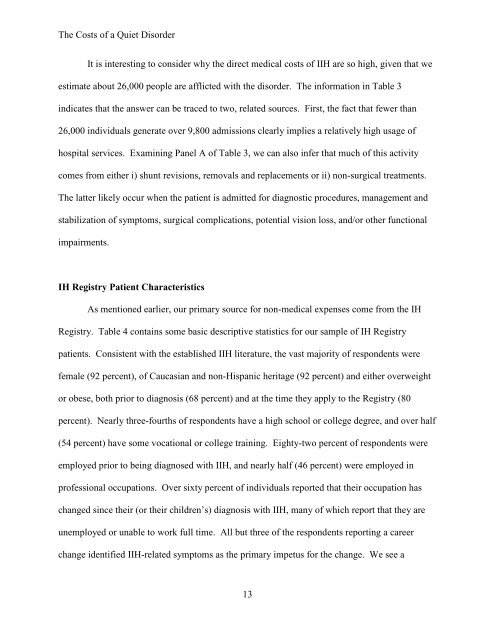Idiopathic Intracranial Hypertension - Washington State University
Idiopathic Intracranial Hypertension - Washington State University
Idiopathic Intracranial Hypertension - Washington State University
- No tags were found...
Create successful ePaper yourself
Turn your PDF publications into a flip-book with our unique Google optimized e-Paper software.
The Costs of a Quiet DisorderIt is interesting to consider why the direct medical costs of IIH are so high, given that weestimate about 26,000 people are afflicted with the disorder. The information in Table 3indicates that the answer can be traced to two, related sources. First, the fact that fewer than26,000 individuals generate over 9,800 admissions clearly implies a relatively high usage ofhospital services. Examining Panel A of Table 3, we can also infer that much of this activitycomes from either i) shunt revisions, removals and replacements or ii) non-surgical treatments.The latter likely occur when the patient is admitted for diagnostic procedures, management andstabilization of symptoms, surgical complications, potential vision loss, and/or other functionalimpairments.IH Registry Patient CharacteristicsAs mentioned earlier, our primary source for non-medical expenses come from the IHRegistry. Table 4 contains some basic descriptive statistics for our sample of IH Registrypatients. Consistent with the established IIH literature, the vast majority of respondents werefemale (92 percent), of Caucasian and non-Hispanic heritage (92 percent) and either overweightor obese, both prior to diagnosis (68 percent) and at the time they apply to the Registry (80percent). Nearly three-fourths of respondents have a high school or college degree, and over half(54 percent) have some vocational or college training. Eighty-two percent of respondents wereemployed prior to being diagnosed with IIH, and nearly half (46 percent) were employed inprofessional occupations. Over sixty percent of individuals reported that their occupation haschanged since their (or their children’s) diagnosis with IIH, many of which report that they areunemployed or unable to work full time. All but three of the respondents reporting a careerchange identified IIH-related symptoms as the primary impetus for the change. We see a13
















